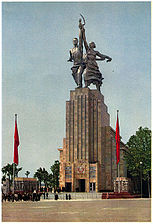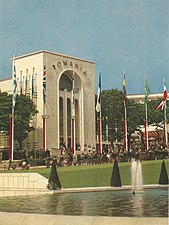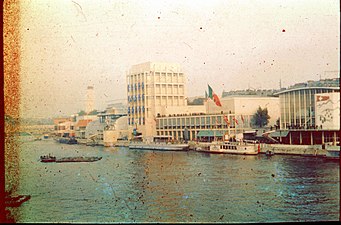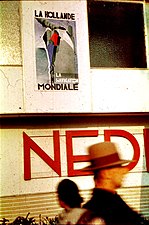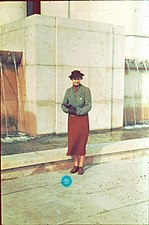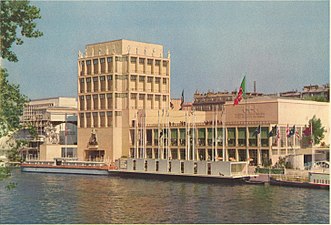
Exposition Internationale des Arts et Techniques dans la Vie Moderne
The Exposition Internationale des Arts et Techniques dans la Vie Moderne (International Exposition of Art and Technology in Modern Life) was held from 25 May to 25 November 1937 in Paris, France. Both the Palais de Chaillot, housing the Musée de l'Homme,[1] and the Palais de Tokyo, which houses the Musée d'Art Moderne de la Ville de Paris, were created for this exhibition that was officially sanctioned by the Bureau International des Expositions. A third building, Palais d'Iéna, housing the permanent Museum of Public Works, which was originally to be among the new museums created on the hill of Chaillot on the occasion of the Exhibition, was not built until January 1937 and inaugurated in March 1939.[2]
1937 Paris
World exposition
Exposition Internationale des Arts et des Techniques appliqués à la vie moderne
101 hectares (250 acres)
31,040,955
45
France
Trocadéro, Champ-de-Mars, Embankment of the Seine
25 May 1937
25 November 1937
Pavilions[edit]
Finnish Pavilion[edit]
The Finnish pavilion was designed by Alvar Aalto, following an open architectural competition held in 1936, where he had won both first and second prize, the winning entry "Le bois est en marche" forming the basis for the pavilion as built. Finland had been given a difficult, sloping wooded site near the Trocadéro, something which Aalto was able to exploit in creating a ground plan featuring an irregular chain of volumes joined in a sort of collage - with small, open, cubic pavilions together with two larger exhibition halls.[4] The entire complex curved around a shady garden with Japanese touches. The pavilion was also an advertisement for Finland's prime export, wood, as the building was built entirely of timber. French architecture historian Fabienne Chevallier has argued that at the time French critics were baffled by Aalto's building because though it was built of wood – and thus endorsing an image of what they perceived Finland to be – they were unprepared for Aalto's avant-gardism.[5]
Canadian Pavilion[edit]
Canada had initially not planned to take part in the exposition because of reasons of cost. In February 1936, at a party in Ottawa, Raymond Brugère, the French minister-plenipotentiary pressed the prime minister William Lyon Mackenzie King and his Quebec lieutenant Ernest Lapointe, about Canada taking part in the Exposition Internationale des Arts et Techniques dans la Vie Moderne, saying he very much wanted Canada to have a pavilion.[6] King hesitated, saying he did not know if his government could afford the cost of building a pavilion, but Brugère forced his hand by sending a telegram to Paris, saying that Canada would take part, leading to an announcement being made in Paris.[6]
Fitting in the architectural master-plan of the master architect Jacques Gréber at the foot of the Eiffel Tower, and inspired by the shape of a grain elevator, the Canadian pavilion included Joseph-Émile Brunet's 28-foot sculpture of a buffalo (1937), and Charles Comfort's The Romance of Nickel.[7] Paintings by Brunet, sculpted panels on the outside of the structure, and several thematic stands inside the Canadian pavilion depicted aspects of Canadian culture.[8]
Norwegian Pavilion[edit]
The Norwegian pavilion was designed by Knut Knutsen, Arne Korsmo and Ole Lind Schistad.[9] It included Hannah Rygen's tapestry Ethiopia.[10]
Spanish Pavilion[edit]
The Spanish pavilion was arranged by the President of Spain Spanish Republican government and built by the Spanish architect Josep Lluis Sert. It attracted extra attention because the exposition took place during the Spanish Civil War.[11] The pavilion included Pablo Picasso's Guernica, the now-famous depiction of the horrors of war,[12] as well as Alexander Calder's sculpture Mercury Fountain and Joan Miró's painting Catalan peasant in revolt.[13]
German Pavilion[edit]
Two of the other notable pavilions were those of Nazi Germany and the Soviet Union. The organization of the world exhibition had placed the German and the Soviet pavilions directly across from each other.[14] Hitler had desired to withdraw from participation, but his architect Albert Speer convinced him to participate, showing Hitler his plans for the German pavilion. Speer later revealed in his autobiographies that having had a clandestine look at the plans for the Soviet pavilion, he designed the German pavilion to represent a bulwark against Communism.
The preparation and construction of the exhibits were plagued by delay. On the opening day of the exhibition, only the German and the Soviet pavilions had been completed. This, as well as the fact that the two pavilions faced each other, turned the exhibition into a competition between the two great ideological rivals.
Speer's pavilion was culminated by a tall tower crowned with the symbols of the Nazi state: an eagle and the swastika. The pavilion was conceived as a monument to "German pride and achievement". It was to broadcast to the world that a new and powerful Germany had a restored sense of national pride. At night, the pavilion was illuminated by floodlights. Josef Thorak's sculpture Comradeship stood outside the pavilion, depicting two enormous nude males, clasping hands and standing defiantly side by side, in a pose of mutual defense and "racial camaraderie".[14] Television was shown as a novelty in German pavilion.
Reproduction of the Soviet Pavilion[edit]
After the Paris exhibition closed, Worker and Kolkhoz Woman was moved to the entrance of the All-Russia Exhibition Centre in Moscow, where it stood on a high platform. The sculpture was removed for restoration in 2003, intended to be completed by 2005. However, due to financial issues the restoration was delayed. On 28 November 2009 the sculpture was completed and returned to its place in front of the VDNKh. On 4 December 2009 the sculpture was revealed on the recreated pavilion structure.[28]

